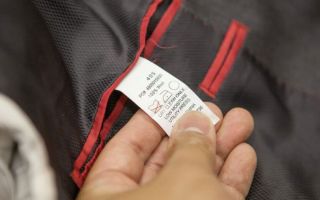Content
Any store clothing must have a label containing information on the composition of the fabric and the rules for processing the item. It is a handy compact instruction manual made up of special characters established by the international standard. Its analogue, GOST ISO 3758—2010, is valid in Russia. The images on the tags, regardless of the place of production of the clothes, will be recognizable all over the world. Signs for washing on clothes, decoding, table is presented below.
Why do we need washing icons on things
The badges on the laundry label help to properly care for your wardrobe and prevent premature wear. Thanks to skillful use, clothes do not tear longer and retain their original shape and color. The tags on the products contain useful information on how to properly wash, wring, iron, bleach, dry the item. The main thing is to know the decoding of these signs.
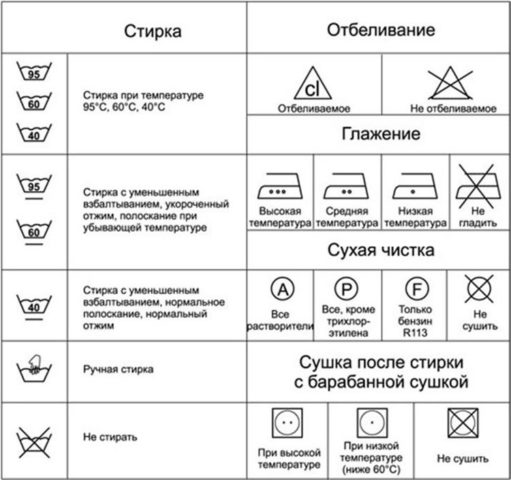
Where to look for washing icons on things
Tags with signs are placed in the seams on the seamy side. They are often found on the side or back. Labels can be printed from the wrong side of the upper back of the product. All information can be placed on a tag or on two (on one the composition of the material, on the other the rules of washing).
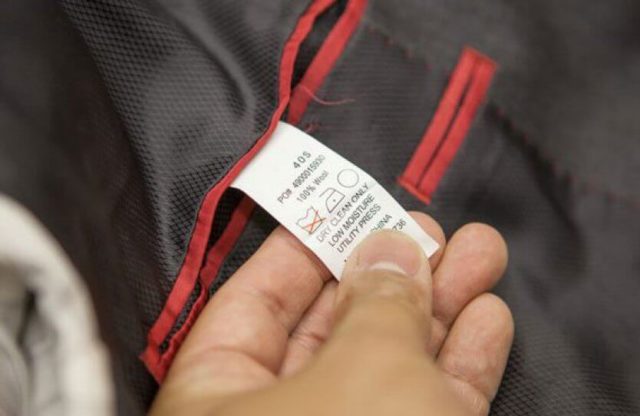
Deciphering the meaning of signs on clothes for washing
Before washing, you need to read the information on the label and decide on the washing mode. To adhere to the rules, you need to know the symbols on the clothes for washing and the decoding of signs.
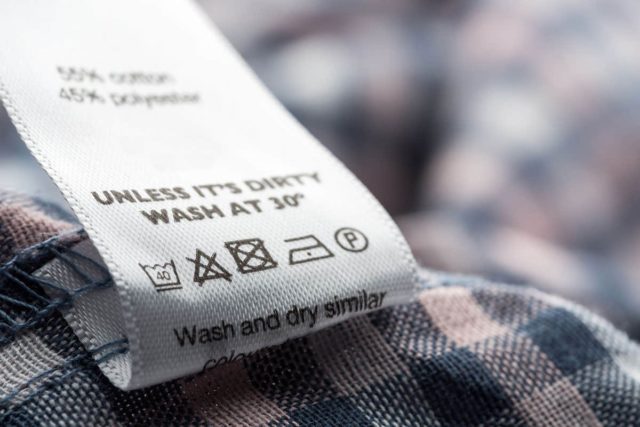
There are five main washing marks on clothing labels:
- Picture of a basin of water... The decoding is intuitively clear: the point is that the thing can be washed. The symbol may contain a number or circles (dots) that indicate the temperature of the water.
- Square... Spin and dry sign. You can find out how to do this by the symbols inside.
- Triangle... Informs about the possibility of product bleaching. The signs inside are about the conditions of this procedure.
- A circle... Indicates whether dry cleaning is allowed. Additionally, its type (dry or wet), recommended chemicals are indicated.
- Iron... The sign is understandable without decoding. Additional symbols or numbers show the recommended temperature.
There are several additional designations of washing modes on clothes, their decoding is as follows:
- Crossing the symbol crosswise is a prohibition of this method of leaving.
- The horizontal line under the icon is the softening of the processing mode.
- Double horizontal line under the symbol - delicate wash.
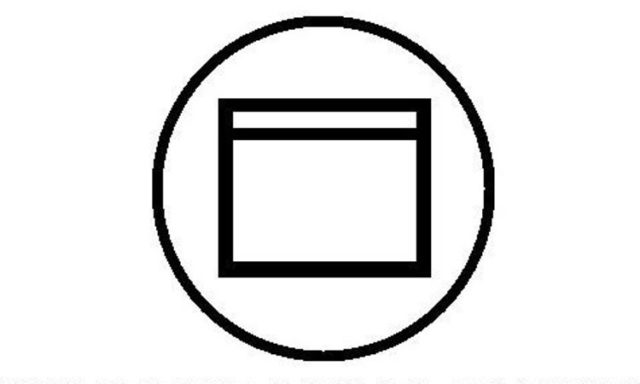
Wash
The decoding of the image of a basin of water is known to almost everyone. This symbol means that the item can be washed. The sign for washing on linen, crossed out with a cross, indicates that the item of clothing must be carried to dry cleaning. The permissible temperature can be indicated by numbers or dots. A basin with a hand lowered into it indicates that the thing requires delicate processing without special mechanical and thermal effects. The rest of the designations on the clothes for washing in the table.
|
Boiled for white and colored cotton and linen |
|
|
In hot water 60 ° C for fine cotton and polyester |
|
|
Maximum temperature 40 ° C for dark variegated and colored items made of cotton, viscose, melange, synthetic fabrics |
|
|
In cold water, no higher than 30 ° C for woolen products |
|
|
Hand wash mark without graters and spinning at 30-40 ° C |
|
|
Icon - no washing, only dry cleaning is allowed |
|
|
Washing allowed |
|
|
Gentle wash in compliance with temperature conditions without heavy mechanical processing |
|
|
Delicate wash in plenty of water with a minimum of mechanical stress and a quick rinse |
|
|
At 30 ° C |
|
|
At 35 ° C |
|
|
At 60 ° C |
On some labels, you can see a symbolic image of the washing machine. This means machine washable. Temperatures are indicated by numbers or dots. If the symbol is crossed out with a cross, the decoding of the icon - cannot be machine washed.
Spinning and drying
Be sure to pay attention to the instructions regarding spinning in the washing machine and drying. If these recommendations are not followed, the product may be deformed or damaged. The signs and their meaning in the table will help you choose the correct washing program.
|
Drying allowed |
|
|
Can't dry |
|
|
It is allowed to dry and wring in the washing machine |
|
|
Do not tumble dry or wring |
|
|
Gentle drying and spinning mode |
|
|
Delicate drying and spinning mode |
|
|
Drying at low temperatures |
|
|
At medium temperature |
|
|
At high temperatures |
|
|
On a horizontal surface |
|
|
Without spinning |
|
|
Vertical |
|
|
In the shadow |
|
|
You can't wring out |
Whitening
There is information on the label about the additional treatment that whitening belongs to. Ignoring the recommendations can lead to damage to the clothes. Signs with decoding in the table below.
|
Whitening allowed |
|
|
Chlorine whitening |
|
|
Whitening is prohibited |
|
|
Whitening without chlorine |
Dry cleaning
Some items cannot be washed by hand or machine. In this case, to remove dirt, the clothes are sent to dry cleaning. You can see dry cleaning marks on clothes next to the wash symbols.
Signs and decoding are presented in the table:
|
Dry cleaning |
|
|
Cannot be dry cleaned |
|
|
Dry cleaning by any means |
|
|
Cleaning with chlorine ethylene, hydrocarbon, monoflotrichloromethane as usual |
|
|
Gentle cleaning with ethylene chloride, hydrocarbon, monoflotrichloromethane |
|
|
Cleaning with triflotrichloromethane and hydrocarbon |
|
|
Gentle cleaning with triflotrichloromethane and hydrocarbon |
Sometimes on the tags you can find an image of a circle with the letter W. Decoding of such a sign - wet cleaning is allowed. If the circle is crossed out with a cross, then water cleaning is prohibited. If there is a horizontal line under the sign, we are talking about delicate processing, if there are two lines - about especially delicate cleaning.
Ironing
After washing the garments, an ironing process may be required. Temperature and steaming information can also be found on the labels. For this, an understandable symbol is used - an image of an iron. If the sign is crossed out with a cross, the product cannot be ironed. Below is an explanation of the most common symbols.
|
Ironing allowed |
|
|
Do not iron (for nylon items) |
|
|
At t up to 110 ° (for synthetic items: acetate, polyacrylic, polyester, polyamide) |
|
|
At t up to 150 ° with an iron with a steam humidifier or through a wet cloth (for wool, cotton, silk, viscose, etc.) |
|
|
At t up to 200 ° (for cotton, flax, wet products) |
|
|
Cannot be steamed (for satin, silk) |
In addition to identification marks for washing, labels may contain inscriptions in English, for example, the following:
- Wash separately (apart from other things).
- Wash before use (wash before first use).
- Wash like colors (with products of the same color).
- Do not add fabric conditioner (no conditioner).
- No optical brighteners (no bleach).
- Do not use softeners (without rinse).
- Do not bleach.
- Do not wring or twist (without wringing and twisting).
- Do not tumble dry.

For example, the picture above shows a label on the clothes. Information decryption: wash in warm water, do not bleach, iron with a hot iron, dry cleaning, normal tumble dry.
Useful Tips
In order for the clothes to retain their original appearance as long as possible, you need to know not only the signs on the tags and their decoding, but also the rules for handling products made from a particular fabric.
Natural materials:
- Cotton... It is recommended to wash clothes at 40 ° C with all-purpose products. For shedding clothes, 30 ° C is sufficient. To keep the color vibrant, you can add a tablespoon of salt to 10 liters of water. Cotton shrinks after washing. Machine drying is acceptable, but shrinkage will be greater. Iron with a moderately hot iron.
- Silk... Hand wash only at 30 ° C without spinning. Use only special shampoos and other products for silk fabrics. Be sure to dry in a flattened form, preferably on a horizontal surface, but you can also vertically. Iron only dry through the fabric from the wrong side.
- Linen... Temperature - no higher than 60 ° C. Linen should not be bleached with chlorine-containing products. Optimal drying - in the fresh air, the main thing is not to dry out. Iron on the front side with a hot iron. The fabric shrinks and wrinkles a lot.
- Wool... Machine wash in special mode or by hand. Temperature - 30 to 40 ° C. Apply liquid or powder products with lanolin. Place items in special bags before putting them in the machine. Spin - 600 revolutions. Dry only on a horizontal surface to avoid deformation. Iron through a dry cloth from the inside out with a warm iron. Do not twist clothes when washing by hand.
- Chiffon... Hand wash only with shampoo in cool water - up to 30 ° C. You can squeeze it slightly, but not twist it. Dry on a horizontal surface or vertically, always flattened.
- Bamboo... Machine and hand washable only at low temperatures - up to 30 ° C. Whitening and dry cleaning are prohibited. Iron with a medium heat.
- Velours... Do not soak, use bleach or other active additives. Machine wash or hand wash at 30 ° C. Do not dry in the sun. Iron with a steam generator.
- Knitwear... The choice of the program depends on the composition. Place knitted items in laundry bags, use delicate products, soap solution, shampoo. Water - 40 ° C. When spinning, do not twist, handle with care. Dry only horizontally, spread out on a sheet. Iron from the wrong side, heat the iron to 110 ° C.
Artificial fabrics:
- Viscose... A delicate wash is required, the temperature is not higher than 40 ° C, no spinning. You cannot twist, remove excess water by rolling the product into a sheet with a roller. Iron through a damp cloth at an iron temperature of 150 ° C.
- Acetate... Wash by soaking at temperatures up to 70 ° C and further hand rinsing. Drying outside, ironing is undesirable or in a gentle mode (for silk).
- Polyamide... Machine wash or hand wash at a temperature not exceeding 40 ° C. Machine drying is not recommended. Iron with a lukewarm iron, do not steam.
- Acrylic... You can wash it by hand and in a typewriter without restrictions, since the material does not deform. It is not recommended to boil.
- Polyester... Gentle operation up to 40 ° C without spinning, otherwise creases will form. Lay to dry on a horizontal surface, hanging on a hanger.
- Sintepon... Wash in cool water by hand or in a typewriter on a delicate cycle. The material holds its shape well and does not lose it during washing and drying. Ironing is usually not required, but if necessary, you can walk with a warm iron.
If there were no symbols for washing on the clothes or their decoding is unknown, you should be guided by the composition of the fabric, assessing it visually, select a program suitable for this material in the machine.
It is not recommended to place items made of different fabrics in one load, for example, natural items with synthetic ones.
It is necessary to separate black, white and colored objects.
Whitening products must be used with great care.
It is better to refuse to spin at high speeds - this way the clothes will last longer.
It is recommended to tumble dry only in extreme cases.
It is still better to wash some things by hand in order to avoid the appearance of pellets, clues and even holes. These are bras, items with lace, embroidery, cashmere, woolen and corduroy items. This also applies to outerwear. For example, there are almost always permissive icons for washing on a jacket or down jacket, but it is better to give such things to dry cleaning. Professional processing will avoid drips and other unpleasant moments.
Conclusion
Washing signs on clothes, decoding, table will help the hostess not only properly clean the laundry from dirt, but also sort it before washing. It is important to take into account not only the color, but also the composition of the fabric, the permissible temperature, the rules for spinning and drying.

